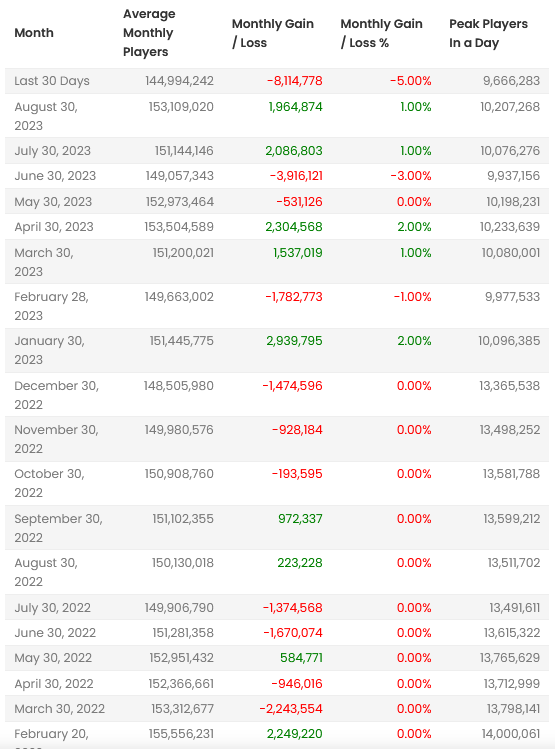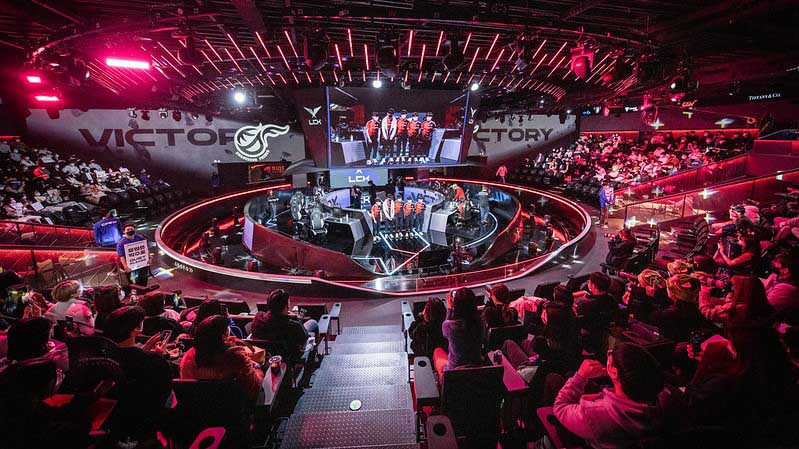Introduction - Why are people interested when a game is dying?
In the ever-evolving world of gaming, the rise and fall of titles is a natural phenomenon. Games that once dominated the charts and captured the hearts of millions can, over time, see a decline in their player base and overall popularity. But why does the potential decline of a game generate so much interest and discussion among gamers and industry enthusiasts?
The life cycle of a game is akin to a gripping narrative. It has its moments of triumph, innovation, and peak popularity, followed by challenges, competition, and sometimes, decline. When whispers of a game "dying" begin to circulate, it's not just a reflection of dwindling player numbers or reduced revenue. It's about the end of an era, the potential fading of shared memories, experiences, and communities that were built around that game.
For many, it's personal. Gamers invest time, energy, and often, emotion into their favorite titles. They form bonds with other players, create content, and immerse themselves in the game's universe. When that world shows signs of waning, it's akin to a favorite TV show nearing its finale. There's a mix of nostalgia, sadness, and a hunger for understanding the "why" behind it all.
Moreover, the discussion around a game's potential decline is also a reflection of the industry's dynamic nature. It's a testament to how new technologies, changing player preferences, and market competition can influence the trajectory of even the most iconic titles. Analyzing these patterns offers insights into the future of gaming, helping players and developers alike prepare for what's next.
In this context, the question of whether "League of Legends," a titan in the MOBA genre, is dying, has garnered significant attention. Through various lenses, from player statistics to esports viewership, we'll delve into this topic, aiming to provide a comprehensive understanding of where LoL stands in the current gaming landscape.
Is League of Legends dying?

In short? No, League of Legends is not dying. However why a lot of people say it is a complicated subject so lets get into the details.
As one of the pioneers in the MOBA (Multiplayer Online Battle Arena) genre, it has garnered a massive global following, established a dominant esports scene, and cultivated a rich community of players, content creators, and fans. Over the years, the game has seen its ups and downs, but the question of its decline is not just a matter of numbers but also of cultural impact, community sentiment, and industry trends.
Several factors come into play when assessing the vitality of a game:
- Player Base and Engagement: A game's active player count is a direct indicator of its health. While LoL has seen fluctuations, it still boasts a significant number of players. In 2023, reports indicated that over 200 million players logged in monthly, showcasing its enduring appeal. However, it's essential to consider regional variations, with some areas experiencing growth and others seeing a decline.
- Esports Scene: LoL's esports ecosystem, from regional leagues to international tournaments, has been a significant driver of its popularity. While some regions have seen a dip in viewership, events like the World Championship continue to attract millions of viewers globally. The esports scene's vibrancy is a testament to the game's competitive allure and its ability to engage fans in a broader narrative.
- Community Feedback: The voice of the community is crucial. Forums, social media platforms, and content creation sites like Reddit and YouTube are rife with discussions about the game's state. While some express concerns about game balance, others laud Riot's continuous efforts to introduce new content and keep the game fresh.
- Industry Competition: The gaming industry is dynamic, with new titles constantly emerging. Games like VALORANT, also from Riot Games, have attracted a portion of the LoL community. However, while new games can lead to shifts in player attention, it doesn't necessarily signal the death of older titles. Instead, it reflects the evolving tastes of the gaming community.
- Developer Engagement: Riot Games' commitment to LoL is evident in their regular updates, champion releases, and engagement with player feedback. Their proactive approach to addressing concerns and introducing innovations plays a pivotal role in retaining the player base.
In conclusion, while League of Legends has faced challenges and competition, it remains a significant force in the gaming world. The multifaceted nature of its appeal, from casual gameplay to high-stakes esports, ensures that it continues to resonate with a broad audience. While the game may evolve and the community's preferences might shift, LoL's legacy and impact on the gaming industry are undeniable. Declaring it as "dying" would be an oversimplification of its complex and ever-evolving journey.
League player counts: How many still play?

League of Legends, since its inception, has been a beacon of success in the gaming world, setting benchmarks in player engagement and community growth. Over the years, its player counts have been a testament to its enduring appeal and adaptability. While games often see fluctuations in their player base, LoL's numbers have consistently been impressive, even amidst the rise of new gaming titles. Let's delve deeper into the specifics of these counts, breaking them down region by region. Are you interested in official statistics released by Riot Games? Read our dedicated article “How Many People Play League of Legends - UPDATED 2022”

How many players play in each region?
Note that this section has been written based on the data from Activeplayer.io. The methodology used there is questionable at best. First of all because API will tell you only how many accounts are there and not the amount of players. Secondly China has no public API so it’s questionable to us how they got the 75 mln players figure.
Last official figures we got from Riot is 180 million monthly logins. However if a same user logged in to more than one Riot’s game he would be counted as a unique user for each game he logged into.
League of Legends' global appeal is evident in its widespread player base across various regions. The game's adaptability to different cultures, coupled with Riot Games' strategic localization efforts, has ensured its popularity in diverse parts of the world. Let's break down the player distribution by region:
- China: Often considered the epicenter of the LoL community, China boasts the largest player base. As of 2023, China alone accounts for approximately 75 million active monthly players. The game's integration with Tencent, a major Chinese conglomerate, and the country's rich esports culture have contributed to its immense popularity in the region.
- Europe West (EUW): Europe has always been a stronghold for LoL, with the EUW server being one of the most active. Recent statistics indicate around 30 million active monthly players in this region. The European esports scene, particularly the LEC (League of Legends European Championship), has played a significant role in maintaining and growing this number.
- North America (NA): Historically a significant player in the LoL community, the NA region has seen some fluctuations but still maintains a strong presence with approximately 20 million active monthly players. The LCS (League of Legends Championship Series) in North America continues to be a major draw, fostering community engagement and interest.
- Korea: The birthplace of esports, Korea has a deeply rooted LoL culture. With around 15 million active monthly players, the region's competitive spirit is evident in its high-level gameplay and the prominence of the LCK (League of Legends Champions Korea).
- Other Regions: Regions like Europe Nordic & East (EUNE), Latin America North (LAN), Latin America South (LAS), Brazil, Turkey, Russia, Japan, and Southeast Asia collectively contribute to the game's global player count. Each of these regions has millions of active players, with numbers ranging from 3 million to 10 million, depending on the region's size and esports infrastructure.
In summary, League of Legends' distribution across regions paints a picture of a game that has successfully tapped into diverse cultures and gaming communities. Its ability to resonate with players from different backgrounds, coupled with Riot Games' continuous efforts to cater to each region's unique needs, ensures its sustained global presence.
Esports event viewership insights

Esports has been a driving force behind the sustained popularity of many online games, and League of Legends is no exception. The competitive scene of LoL, with its high-stakes tournaments and regional leagues, has not only provided thrilling entertainment for fans but has also played a pivotal role in shaping the game's global narrative. Here's a closer look at the viewership trends and insights from major LoL esports events:
- World Championship: Often referred to as "Worlds," this annual event is the pinnacle of LoL esports. Over the years, Worlds has seen record-breaking viewership numbers. In recent times, the event has consistently attracted tens of millions of unique viewers, with peak concurrent viewership often surpassing previous records. The grandeur of the event, combined with international rivalries, makes it a must-watch for fans worldwide.
- Mid-Season Invitational (MSI): Serving as a mid-year global showdown, MSI offers a taste of international competition before Worlds. In 2023, the MSI averaged 796,000 viewers per game, accumulating over 61 million hours watched. The event's format, which brings together champions from each regional league, ensures a diverse and unpredictable competitive landscape.
- Regional Leagues: Each major region has its premier league, such as the LCS in North America, LEC in Europe, LCK in Korea, and LPL in China. While these leagues maintain strong viewership in their respective regions, there have been fluctuations. For instance, the LCS saw a decline from 200,000 average viewers in 2020 to just over 109,000 in the 2023 Spring Split. Conversely, the LPL in China and LCK in Korea have maintained robust viewership numbers, reflecting the regions' deep-rooted esports culture.
- Emerging Regions: Leagues in emerging regions, such as the Pacific Championship Series (PCS), Vietnam Championship Series (VCS), and the Brazilian Championship (CBLOL), have shown promising growth. While their viewership numbers might be lower compared to the major regions, the passion and engagement levels are commendable. These regions represent the future growth potential of LoL esports.
- Shifts in Viewing Platforms: The platforms on which fans consume esports content have evolved. While Twitch remains a dominant platform in the West, platforms like YouTube Gaming have seen increased engagement. In regions like China, platforms such as Douyu and Huya command significant viewership, often surpassing their Western counterparts.
In conclusion, the esports viewership landscape for League of Legends is vast and varied. While certain regions or events might see dips in numbers, the overall engagement remains strong. The game's ability to foster a sense of community, regional pride, and global rivalry ensures that its esports scene remains at the forefront of the industry.
How bad performance of certain regions (NA) makes the game look like its dying
The perception of a game's health is often influenced by various factors, one of which is the performance of its competitive teams on the global stage. In the case of League of Legends, regional performance, especially in high-profile international tournaments, can significantly shape the narrative around the game's vitality and relevance.
North America's Struggles:
North America (NA), represented by the LCS (League of Legends Championship Series), has historically been one of the major regions in the LoL esports ecosystem. However, in recent years, NA teams have faced challenges in international competitions, often failing to progress to the later stages of tournaments like the World Championship. This underperformance has led to several consequences:
- Perception of Decline: When a major region like NA underperforms consistently, it can create a perception that interest and skill in the game are waning in that region. This can lead to broader assumptions that the game itself might be on a decline, especially when coupled with other factors like decreasing viewership numbers for the regional league.
- Community Discontent: The passionate NA fanbase, eager to see their teams succeed on the global stage, often expresses disappointment and frustration. This sentiment can spill over into broader discussions about the game's state, balance issues, and Riot Games' support for the region.
- Impact on Players and Teams: Continuous underperformance can demotivate players and teams. It can lead to roster changes, shifts in team dynamics, and even top players opting to play in other regions, further fueling the narrative of decline.
- Economic Implications: A region's poor performance can have economic repercussions. Sponsors and investors might be hesitant to invest heavily in a region that doesn't produce internationally competitive teams. This can lead to reduced funding for teams, impacting their ability to secure top talent or invest in training infrastructure.
- Comparative Analysis: The contrast becomes starker when NA's performance is juxtaposed with powerhouse regions like China's LPL or Korea's LCK. These regions not only dominate in terms of gameplay but also in viewership, fan engagement, and overall esports culture. Such comparisons can amplify the perception of NA's decline.
In summary, while the performance of teams from a particular region in international tournaments is just one facet of the game's overall health, it plays a significant role in shaping perceptions. For a game as globally interconnected as League of Legends, regional disparities become magnified and can contribute to narratives about the game's overall health. However, it's essential to view these in the broader context of the game's global appeal, innovations, and sustained engagement across multiple regions.
August’s “gacha” controversy threatens player counts
In the gaming industry, controversies can have a profound impact on player sentiment, engagement, and ultimately, player counts. One such incident that recently sent ripples through the League of Legends community was the "gacha" controversy in August.
Understanding the "Gacha" Mechanism:
Originating from Japan, "gacha" is a monetization technique used in many mobile games. It allows players to spend in-game currency (often purchasable with real money) to receive a random item, character, or reward. The allure of rare items and the element of surprise make it a popular, albeit sometimes contentious, feature.
The Controversy:
In August, Riot Games introduced a new "gacha"-style system to League of Legends, allowing players to spend Riot Points (RP) for a chance to unlock rare skins, champions, and other in-game items. While such systems are not uncommon in the gaming world, several issues arose:
- Lack of Transparency: Many players felt that the odds of obtaining the rarest items were not transparently disclosed, leading to accusations of the system being a "money grab" by Riot Games.
- Impact on Player Experience: Traditional players, accustomed to directly purchasing skins or earning them through gameplay, felt that the "gacha" system diluted the value of skins and rewards. The randomness introduced a pay-to-win perception, detracting from the game's competitive integrity.
- Economic Concerns: The system was seen by some as preying on players' gambling tendencies, encouraging them to spend more money in hopes of obtaining desired items. This raised ethical concerns, especially considering the game's younger player base.
- Community Backlash: The introduction of the "gacha" system led to widespread community backlash. Forums, social media platforms, and content creators were abuzz with discussions, criticisms, and calls for boycotts. Many players threatened to leave the game or reduce their spending, potentially impacting the game's revenue and player counts.
- Comparisons with Other Games: The controversy also brought comparisons with other games that had faced backlash for similar systems, further fueling the narrative of League of Legends adopting predatory monetization practices.
Riot's Response:
In the wake of the controversy, Riot Games was quick to address player concerns. They provided clarifications on the odds of the "gacha" system, made adjustments based on feedback, and promised more transparent communication in the future. While this alleviated some concerns, the incident served as a reminder of how quickly player sentiment can shift and the importance of aligning monetization strategies with community values.
In conclusion, the "gacha" controversy highlighted the delicate balance game developers must maintain between monetization and player satisfaction. While such incidents can threaten player counts in the short term, they also offer valuable lessons on community engagement and the evolving expectations of the gaming audience.





